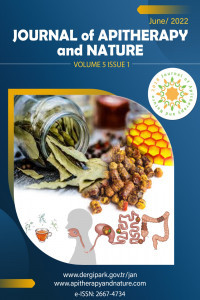A Preliminary Study: The Selective Effect of Bee Venom on Inhibition of Cell Migration in Metastatic Breast Cancer Cells Over Normal Cells in Comparison with Cisplatin
A Preliminary Study: The Selective Effect of Bee Venom on Inhibition of Cell Migration in Metastatic Breast Cancer Cells Over Normal Cells in Comparison with Cisplatin
Apitherapy, cancer cell migration, wound healing,
___
- Badr, G., Hozzein, W. N., Badr, B. M., Al Ghamdi, A., Eldien, H. M. S., & Garraud, O. (2016). Bee Venom Accelerates Wound Healing in Diabetic Mice by Suppressing Activating Transcription Factor-3 (ATF-3) and Inducible Nitric Oxide Synthase (iNOS)-Mediated Oxidative Stress and Recruiting Bone Marrow-Derived Endothelial Progenitor Cells. Journal of Cellular Physiology, 231(10), 2159-2171. doi:10.1002/jcp.25328
- Duffy, C., Sorolla, A., Wang, E., Golden, E., Woodward, E., Davern, K., . . . Blancafort, P. (2020). Honeybee venom and melittin suppress growth factor receptor activation in HER2-enriched and triple-negative breast cancer. Npj Precision Oncology, 4(1). doi:ARTN 24 10.1038/s41698-020-00129-0
- Flake, G., Moore, B., Sutton, D., Kissling, G., Horton, J., Wicker, B., . . . Dixon, D. (2013). The natural history of uterine leiomyomas: light and electron microscopic studies of fibroid phases, interstitial ischemia, inanosis, and reclamation. Obstet Gynecol Int, 528376.
- Gandalovicova, A., Rosel, D., Fernandes, M., Vesely, P., Heneberg, P., Cermak, V., . . . Brabek, J. (2017). Migrastatics-Anti-metastatic and Anti-invasion Drugs: Promises and Challenges. Trends in Cancer, 3(6), 391-406. doi:10.1016/j.trecan.2017.04.008
- Grada, A., Otero-Vinas, M., Prieto-Castrillo, F., Obagi, Z., & Falanga, V. (2017). Research Techniques Made Simple: Analysis of Collective Cell Migration Using the Wound Healing Assay. Journal of Investigative Dermatology, 137(2), E11-E16. doi:10.1016/j.jid.2016.11.020
- Han, S., Lee, K., Yeo, J., Kim, W., & Park, K. (2011). Biological effects of treatment of an animal skin wound with honeybee (Apis melifera. L) venom. Journal of Plastic Reconstructive and Aesthetic Surgery, 64(3), E67-E72. doi:10.1016/j.bjps.2010.08.022
- Horak, C. E., Lee, J. H., Marshall, J. C., Shreeve, S. M., & Steeg, P. S. (2008). The role of metastasis, suppressor genes in metastatic dormancy. Apmis, 116(7-8), 586-601. doi:DOI 10.1111/j.1600-0463.2008.01027.x
- Hozzeinab, W. N., Badr, G., Badr, B. M., Allam, A., Al Ghamdi, A., Al-Wadaan, M. A., & Al-Waili, N. S. (2018). Bee venom improves diabetic wound healing by protecting functional macrophages from apoptosis and enhancing Nrf2, Ang-1 and Tie-2 signaling. Molecular Immunology, 103, 322-335. doi:10.1016/j.molimm.2018.10.016
- Maeng, Y., Kim, K. T., Zhou, X., Jin, L. T., Kim, K. S., Kim, Y. H., . . . Li, X. K. (2018). A novel microbial technique for producing high-quality sophorolipids from horse oil suitable for cosmetic applications. Microbial Biotechnology, 11(5), 917-929. doi:10.1111/1751-7915.13297
- Poulose, N., Sajayan, A., Ravindran, A., Sreechithra, T. V., Vardhan, V., Selvin, J., & Kiran, G. S. (2020). Photoprotective effect of nanomelanin-seaweed concentrate in formulated cosmetic cream: With improved antioxidant and wound healing properties. Journal of Photochemistry and Photobiology B-Biology, 205. doi:10.1016/j.jphotobiol.2020.111816
- Rady, I., Siddiqui, I. A., Rady, M., & Mukhtar, H. (2017). Melittin, a major peptide component of bee venom, and its conjugates in cancer therapy. Cancer Letters, 402, 16-31. doi:10.1016/j.canlet.2017.05.010
- Roy, A., & Bharadvaja, N. (2020). Venom-Derived Bioactive Compounds as Potential Anticancer Agents: A Review. International Journal of Peptide Research and Therapeutics. doi:10.1007/s10989-020-10073-z
- Tetikoglu, S. (2020). Investigation of the long-term cytotoxic effect of bee venom onliver and metastatic breast cancer cells. (Master of Science), Karadeniz Technical University.
- Yue, F., Cheng, Y., Breschi, A., Vierstra, J., Wu, W. S., Ryba, T., . . . Consortium, M. E. (2014). A comparative encyclopedia of DNA elements in the mouse genome. Nature, 515(7527), 355-+. doi:10.1038/nature13992
- Yayın Aralığı: Yılda 2 Sayı
- Başlangıç: 2018
- Yayıncı: Oktay YILDIZ
Sterilization of Indian Honey with Cobalt 60 Gamma Irradiation
Amit Kumar JAİN, Apoorva HC, Prakash R
Soner KARABULUT, Selcen ÇELİK UZUNER
Determination of the Hardness and the Parameters of the Surface Roughness in Peach Wood
Fatiha ABDELLAH, Chahra MAKHLOUFI, Laïd BOUKRAA, Si Mohammed HAMMOUDI, Amel SAFA, Nouria DELLEL, Asma BENAMARA, Mamia BENHADIRI, Nesrine MAROUF, Rachida BENARABA
